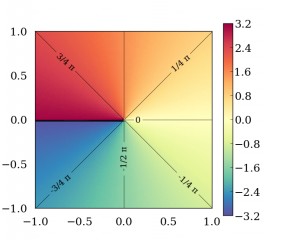std::atan2
From cppreference.com
| Defined in header <cmath>
|
||
| float atan2( float y, float x ); |
(1) | |
| double atan2( double y, double x ); |
(2) | |
| long double atan2( long double y, long double x ); |
(3) | |
| Promoted atan2( Arithmetic y, Arithmetic x ); |
(4) | (since C++11) |
Computes the inverse tangent of y/x using the signs of arguments to correctly determine quadrant.
4) If any argument has integral type, it is cast to double. If any other argument is long double, then the return type is long double, otherwise it is double.
Contents |
[edit] Parameters
| x, y | - | floating point value |
[edit] Return value
Arc tangent of y/x in radians in the range of [-π; π] radians.
[edit] Example
#include <cmath> #include <utility> #include <iostream> std::pair<double, double> cartesian_to_polar(double x, double y) { return {std::hypot(x, y), std::atan2(y,x)}; } int main() { std::pair<double, double> polar = cartesian_to_polar(1, 1); std::cout << "(1,1) cartesian is (" << polar.first << "," << polar.second<< ") polar\n"; }
Output:
(1,1) cartesian is (1.41421,0.785398) polar
[edit] See also
| computes arc tangent (arctan(x)) (function) | |
| computes arc sine (arcsin(x)) (function) | |
| computes arc cosine (arccos(x)) (function) | |
| computes tangent (tan(x)) (function) | |
